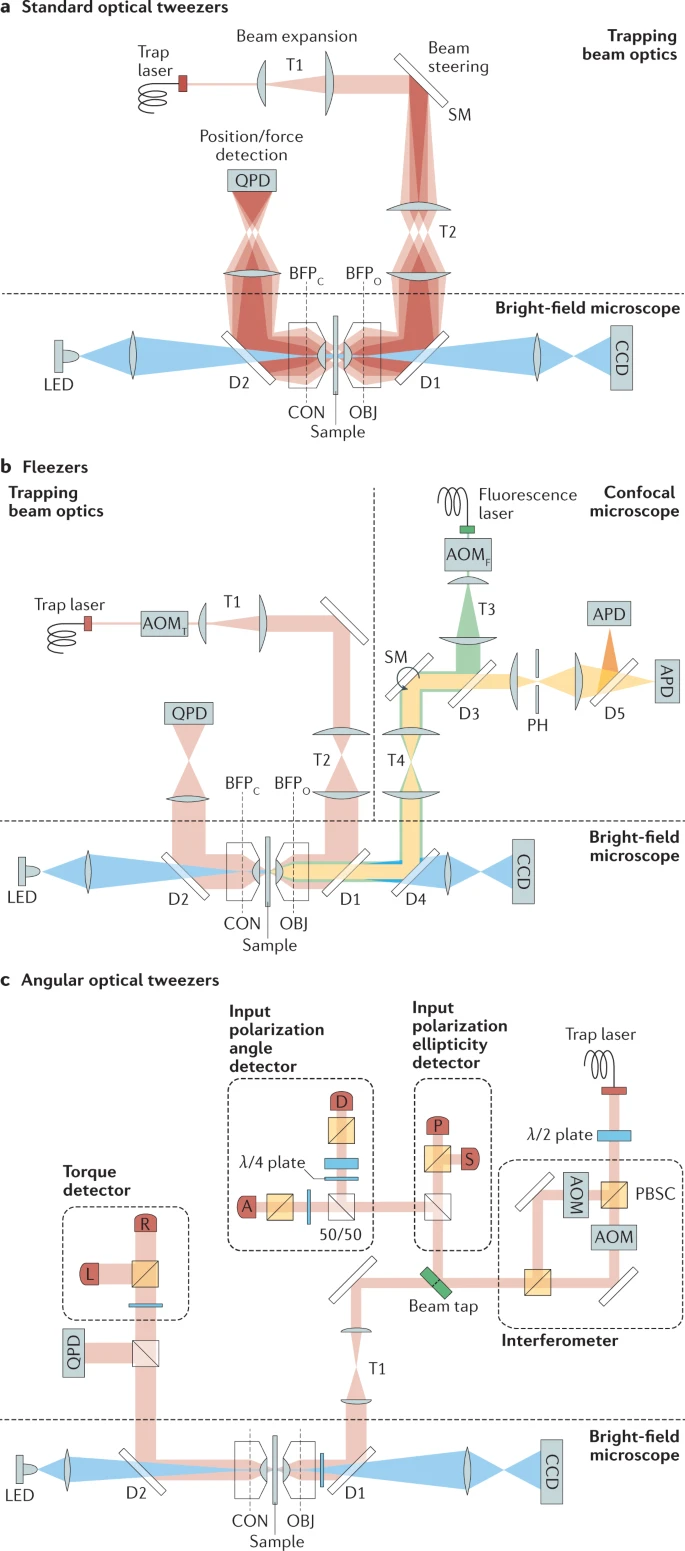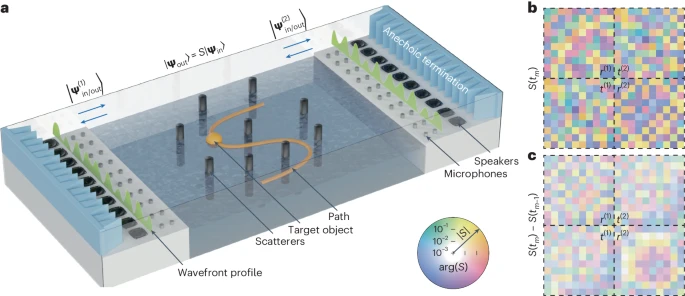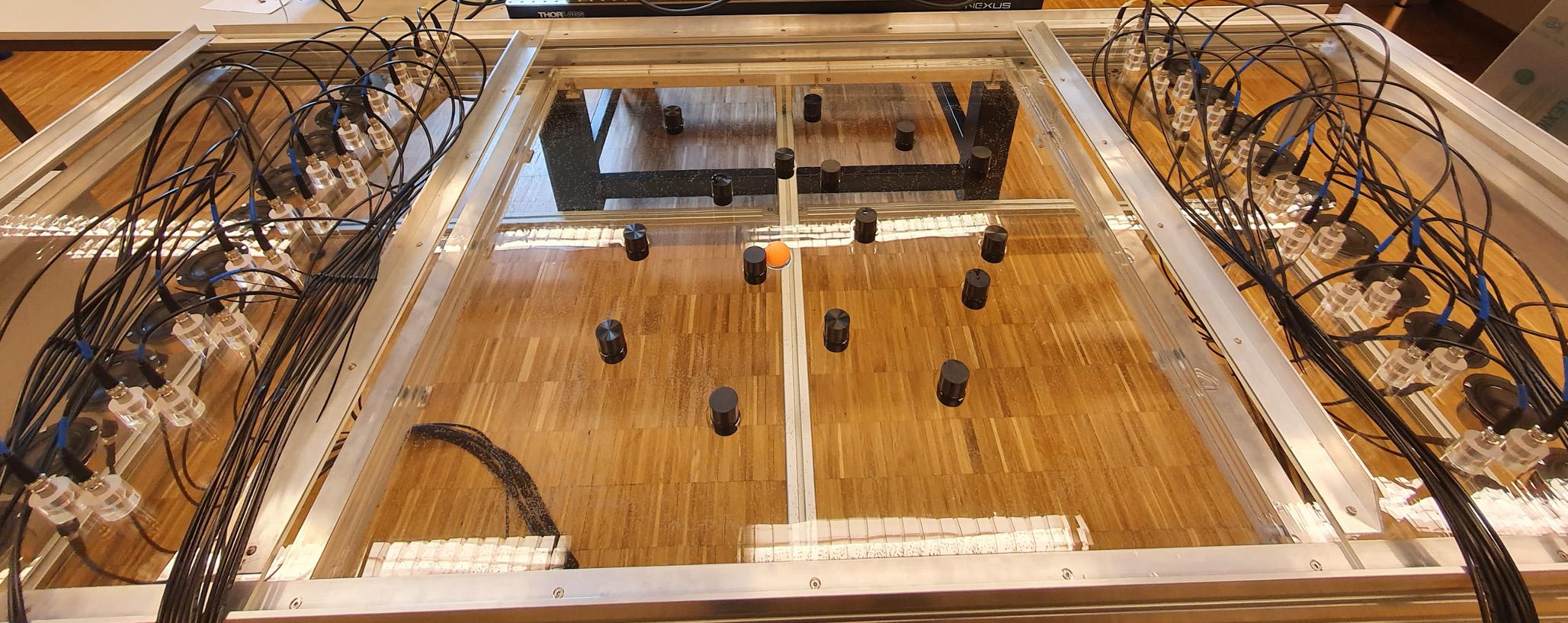6.25.24
Celia Luterbacher

© iStock
EPFL researchers have succeeded in directing floating objects around an aquatic obstacle course using only soundwaves. Their novel, optics-inspired method holds great promise for biomedical applications such as noninvasive targeted drug delivery.
In 2018, Arthur Ashkin won the Nobel Prize in Physics for inventing optical tweezers: laser beams that can be used to manipulate microscopic particles.
Fig. 2: Basic designs of optical traps.

a | Optical layout of a standard single-beam optical trap. A high-power laser generates the trapping beam (pink), which is expanded by telescope T1. Beam-steering optics (here, a steerable mirror (SM)) control the tilt in the beam axis. A high-numerical aperture objective (OBJ) focuses the trapping beam into the sample. T2 images the steering plane (at SM) onto the objective back focal plane (BFPO), so that tilting the beam displaces the trap in the sample plane. A condenser (CON) collects the light scattered by the trapped particle. A lens images the light at the condenser back focal plane (BFPC) onto a position-sensitive quadrant photodetector (QPD) for position/force detection. Two dichroic mirrors (D1 and D2) reflect the trapping beam and transmit visible light (blue) for bright-field illumination (light-emitting diode (LED)) and imaging (charge-coupled device (CCD)) of the sample plane. b | Optical layout for a representative fleezers set-up (dual traps with a confocal microscope)43. A fluorescence excitation beam (green) is expanded (T3) and directed (D3, SM, T4, D4) into the trapping OBJ. The OBJ focuses the beam to a diffraction-limited spot on the sample plane and collects light emitted within the spot. The excitation spot is displaced in the sample plane by a SM. The emitted light (yellow) travels back along the emission path, passing through a dichroic mirror (D3) and into a pinhole aperture (PH) to reject out-of-focus light. Emission light is detected by an avalanche photodiode (APD) (or by two APDs for Förster resonance energy transfer measurements). The trapping and fluorescence excitation beams are interlaced by two out-of-phase acousto-optic modulators (AOMT and AOMF, respectively). The trap layout is similar to that shown in part a, with dual traps generated by time-sharing using AOMT. c | Representative optical layout of angular optical tweezers101. The trapping laser is linearly polarized and split equally into two orthogonally polarized beams at a polarization beam splitter cube (PBSC). Each beam then passes through an AOM, and the two beams are recombined at another PBSC. Prior to the objective, the ellipticity of the laser is measured by the ‘input polarization ellipticity detector’ via photodetectors P and S, while the polarization angle is measured by the ‘input polarization angle detector’ via photodetectors A and D. After the laser interacts with a trapped cylinder in the sample plane, the transmitted laser becomes elliptically polarized, and the optical torque is measured by the ‘torque detector’ via photodetectors R and L. The force on the cylinder is measured by a QPD.
Source data
See the science paper for further instructive material with images.
While useful for many biological applications, optical tweezers require extremely controlled, static conditions to work properly.
“Optical tweezers work by creating a light ‘hotspot’ to trap particles, like a ball falling into a hole. But if there are other objects in the vicinity, this hole is difficult to create and move around,” says Romain Fleury, head of the Laboratory of Wave Engineering in EPFL’s School of Engineering.
Fleury and postdoctoral researchers Bakhtiyar Orazbayev and Matthieu Malléjac have spent the last four years trying to move objects in uncontrolled, dynamic environments using soundwaves. In fact, the team’s method – “wave momentum shaping” – is entirely indifferent to an object’s environment or even its physical properties. All the information that’s required is the object’s position, and the soundwaves do the rest.
Moving an object with sound despite disorder.
“In our experiments, instead of trapping objects, we gently pushed them around, as you might guide a puck with a hockey stick,” Fleury explains.
The unconventional method, funded by the Swiss National Science Foundation (SNSF) Spark program, has been published in Nature Physics in collaboration with researchers from the University of Bordeaux in France, Nazarbayev University in Kazakhstan, and the Vienna University of Technology in Austria.

a, We consider a parallel-plate acoustic waveguide supporting ten modes at the working frequency. It contains cylindrical rigid scatterers (in black). The bottom surface of this waveguide is formed by the water in this container, so that the spherical object (orange ball) can float and move freely. Wave-momentum shaping consists of finding and sending, at each time tm, the optimal mode mixture to push the ball along an arbitrarily chosen path (orange line). We achieve this by real-time far-field measurements, which allow us to track the evolution of the scattering matrix S as the object moves. We deduce the wavefronts to be injected by the external speaker arrays such that they optimally deliver the target momentum. b, Example of a scattering matrix measured at a given time tm in our experiment. c, Difference between the scattering matrix at tm and the one measured at tm−1, showing the influence of the translation of a small object on scattering. We use the information collected at three consecutive time steps to derive the mode mixture that optimally pushes the ball in the desired direction. The static scatterers are later replaced with dynamic ones.
Very simple, very promising
If soundwaves are the hockey stick in Fleury’s analogy, then a floating object like a ping-pong ball is the puck. In the lab’s experiments, the ball was floating on the surface of a large tank of water, and its position was captured by an overhead camera. Audible soundwaves emitted from a speaker array at either end of the tank directed the ball along a pre-determined path, while a second array of microphones ‘listened’ to the feedback, called a scattering matrix, as it bounced off of the moving ball. This scattering matrix, combined with the camera’s positional data, allowed the researchers to calculate in real time the optimal momentum of the soundwaves as they nudged the ball along its path.

The experimental setup, with speakers and microphones at either end of a water tank, and vertical scattering objects at the center. EPFL/LWE CC-BY-SA 4.0
“The method is rooted in momentum conservation, which makes it extremely simple and general, and that’s why it’s so promising,” Fleury says.
He adds that wave momentum shaping is inspired by the optical technique of wavefront shaping, which is used to focus scattered light, but this is the first application of the concept to moving an object. What’s more, the team’s method is not limited to moving spherical objects along a path: they also used it to control rotations, and to move more complex floaters like an origami lotus.
Mimicking conditions inside the body
Once the scientists succeeded in guiding a ping-pong ball, they performed additional experiments with both stationary and moving obstacles designed to add inhomogeneity to the system. Successfully navigating the ball around these scattering objects demonstrated that wave momentum shaping could perform well even in dynamic, uncontrolled environments like a human body. Fleury adds that sound is a particularly promising tool for biomedical applications, as it is harmless and noninvasive.
“Some drug delivery methods already use soundwaves to release encapsulated drugs, so this technique is especially attractive for pushing a drug directly toward tumor cells, for example.”
Experiment with an origami lotus
The method could also be a game-changer for biological analysis or tissue engineering applications where manipulating cells by touching them would cause damage or contamination. Fleury also sees 3D printing applications for wave momentum shaping, for example to arrange microscopic particles before solidifying them into an object.
Ultimately, the researchers believe their method could also work using light, but their next goal is to take their sound-based experiments from the macro- to micro-scale. They have already received SNSF funding to do experiments under a microscope, using ultrasonic waves to move cells around.
See the full article here .
Comments are invited and will be appreciated, especially if the reader finds any errors which I can correct.
five-ways-keep-your-child-safe-school-shootings
Please help promote STEM in your local schools.

The Swiss Federal Institute of Technology in Lausanne [EPFL-École Polytechnique Fédérale de Lausanne] (CH) is a research institute and university in Lausanne, Switzerland, that specializes in natural sciences and engineering. It is one of the two Swiss Federal Institutes of Technology, and it has three main missions: education, research and technology transfer.
The QS World University Rankings ranks EPFL(CH) very high, whereas Times Higher Education World University Rankings ranks EPFL(CH) as one of the world’s best schools for Engineering and Technology.
EPFL(CH) is located in the French-speaking part of Switzerland; the sister institution in the German-speaking part of Switzerland is The Swiss Federal Institute of Technology ETH Zürich [Eidgenössische Technische Hochschule Zürich] (CH). Associated with several specialized research institutes, the two universities form The Domain of the Swiss Federal Institutes of Technology (ETH Domain) [ETH-Bereich; Domaine des Écoles Polytechniques Fédérales] (CH) which is directly dependent on the Federal Department of Economic Affairs, Education and Research. In connection with research and teaching activities, EPFL(CH) operates a nuclear reactor CROCUS; a Tokamak Fusion reactor; a Blue Gene/Q Supercomputer; and P3 bio-hazard facilities.
ETH Zürich, EPFL (Swiss Federal Institute of Technology in Lausanne) [École Polytechnique Fédérale de Lausanne](CH), and four associated research institutes form The Domain of the Swiss Federal Institutes of Technology (ETH Domain) [ETH-Bereich; Domaine des Écoles polytechniques fédérales] (CH) with the aim of collaborating on scientific projects.
The roots of modern-day EPFL(CH) can be traced back to the foundation of a private school under the name École Spéciale de Lausanne in 1853 at the initiative of Lois Rivier, a graduate of the École Centrale Paris (FR) and John Gay the then professor and rector of the Académie de Lausanne. At its inception it had only 11 students and the offices were located at Rue du Valentin in Lausanne. In 1869, it became the technical department of the public Académie de Lausanne. When the Académie was reorganized and acquired the status of a university in 1890, the technical faculty changed its name to École d’Ingénieurs de l’Université de Lausanne. In 1946, it was renamed the École polytechnique de l’Université de Lausanne (EPUL). In 1969, the EPUL was separated from the rest of the University of Lausanne and became a federal institute under its current name. EPFL(CH), like ETH Zürich (CH), and it is thus directly controlled by the Swiss federal government. In contrast, all other universities in Switzerland are controlled by their respective cantonal governments. EPFL(CH) has started to develop into the field of life sciences. It absorbed the Swiss Institute for Experimental Cancer Research (ISREC) in 2008.
In 1946, there were 360 students. In 1969, EPFL(CH) had 1,400 students and 55 professors. In the past two decades the university has grown rapidly and over 14,000 people study or work on campus, about 10,000 of these being Bachelor, Master or PhD students. The environment at modern day EPFL(CH) is highly international with the school attracting students and researchers from all over the world. More than 125 countries are represented on the campus and the university has two official languages, French and English.
Organization
EPFL is organized into eight schools, themselves formed of institutes that group research units (laboratories or chairs) around common themes:
School of Basic Sciences
Institute of Mathematics
Institute of Chemical Sciences and Engineering
Institute of Physics
European Centre of Atomic and Molecular Computations
Bernoulli Center
Biomedical Imaging Research Center
Interdisciplinary Center for Electron Microscopy
MPG-EPFL Centre for Molecular Nanosciences and Technology
Swiss Plasma Center
Laboratory of Astrophysics
School of Engineering
Institute of Electrical Engineering
Institute of Mechanical Engineering
Institute of Materials
Institute of Microengineering
Institute of Bioengineering
School of Architecture, Civil and Environmental Engineering
Institute of Architecture
Civil Engineering Institute
Institute of Urban and Regional Sciences
Environmental Engineering Institute
School of Computer and Communication Sciences
Algorithms & Theoretical Computer Science
Artificial Intelligence & Machine Learning
Computational Biology
Computer Architecture & Integrated Systems
Data Management & Information Retrieval
Graphics & Vision
Human-Computer Interaction
Information & Communication Theory
Networking
Programming Languages & Formal Methods
Security & Cryptography
Signal & Image Processing
Systems
School of Life Sciences
Bachelor-Master Teaching Section in Life Sciences and Technologies
Brain Mind Institute
Institute of Bioengineering
Swiss Institute for Experimental Cancer Research
Global Health Institute
Ten Technology Platforms & Core Facilities (PTECH)
Center for Phenogenomics
NCCR Synaptic Bases of Mental Diseases
College of Management of Technology
Swiss Finance Institute at EPFL
Section of Management of Technology and Entrepreneurship
Institute of Technology and Public Policy
Institute of Management of Technology and Entrepreneurship
Section of Financial Engineering
College of Humanities
Human and social sciences teaching program
EPFL Middle East
Section of Energy Management and Sustainability
In addition to the eight schools there are seven closely related institutions
Swiss Cancer Centre
Center for Biomedical Imaging (CIBM)
Centre for Advanced Modelling Science (CADMOS)
École Cantonale d’art de Lausanne (ECAL)
Campus Biotech
Wyss Center for Bio- and Neuro-engineering
Swiss National Supercomputing Centre


